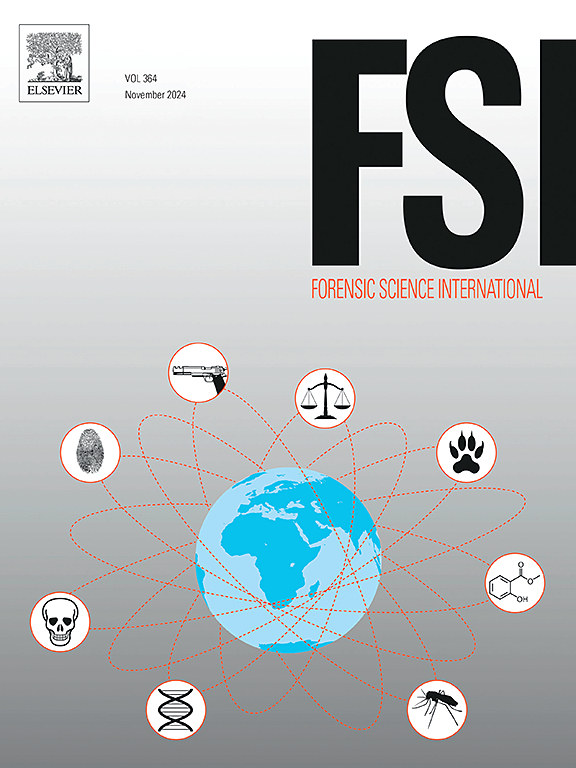Forensic and toxicological insights into aconite poisoning: A retrospective analysis of clinical and postmortem findings
IF 2.2
3区 医学
Q1 MEDICINE, LEGAL
引用次数: 0
Abstract
Aconitine, a highly toxic alkaloid derived from the aconite plant, presents significant clinical and forensic challenges due to its cardiotoxic and neurotoxic effects. It may induce fatal ventricular arrhythmias and severe central nervous system disturbances when improperly used. The diagnosis of aconitine poisoning remains difficult, particularly in postmortem contexts, owing to its rapid metabolism and the non-specific nature of autopsy findings. In this retrospective study, we analyzed 35 reported cases of aconitine poisoning published between 1958 and 2024. Each case was evaluated for demographic characteristics, exposure route, clinical manifestations, treatment approaches, autopsy findings, and toxicological results. Our analysis revealed that the cardiovascular and nervous systems were most commonly affected, with symptom severity varying independently of dosage, suggesting interindividual susceptibility. Blood, urine, liver, and kidney represent the most common biological matrices for toxicological analysis. Hair analysis provides valuable chronological data in chronic exposure assessments, while fecal samples serve as reliable alternatives for postmortem detection when conventional specimens are unavailable or compromised. Notably, alcohol potentiates both the absorption and toxicity of aconitine. Furthermore, transdermal aconitine poisoning has been documented in fatal cases, particularly when applied to compromised skin integrity. These findings highlight the importance of timely toxicological testing and the utility of alternative biological matrices in both clinical and forensic settings, offering important insights for improving diagnostic accuracy and supporting forensic determinations in cases of aconitine poisoning.
乌头中毒的法医和毒理学见解:临床和尸检结果的回顾性分析
乌头碱是一种从乌头植物中提取的剧毒生物碱,由于其对心脏和神经的毒性作用,给临床和法医带来了重大挑战。如果使用不当,可引起致命性室性心律失常和严重的中枢神经系统紊乱。乌头碱中毒的诊断仍然很困难,特别是在死后的情况下,由于其快速代谢和尸检结果的非特异性。在这项回顾性研究中,我们分析了1958年至2024年间发表的35例乌头碱中毒报告。对每个病例的人口学特征、暴露途径、临床表现、治疗方法、尸检结果和毒理学结果进行评估。我们的分析显示,心血管和神经系统最常受到影响,症状严重程度与剂量无关,表明个体间易感性。血液、尿液、肝脏和肾脏是毒理学分析中最常见的生物基质。毛发分析为慢性暴露评估提供了有价值的时间顺序数据,而粪便样本则在无法获得常规样本或受到损害的情况下,作为死后检测的可靠选择。值得注意的是,酒精增强了乌头碱的吸收和毒性。此外,经皮乌头碱中毒已被记录在致命的情况下,特别是当应用于受损的皮肤完整性。这些发现强调了及时毒理学测试的重要性,以及在临床和法医环境中使用替代生物基质的重要性,为提高乌头碱中毒病例的诊断准确性和支持法医鉴定提供了重要见解。
本文章由计算机程序翻译,如有差异,请以英文原文为准。
求助全文
约1分钟内获得全文
求助全文
来源期刊

Forensic science international
医学-医学:法
CiteScore
5.00
自引率
9.10%
发文量
285
审稿时长
49 days
期刊介绍:
Forensic Science International is the flagship journal in the prestigious Forensic Science International family, publishing the most innovative, cutting-edge, and influential contributions across the forensic sciences. Fields include: forensic pathology and histochemistry, chemistry, biochemistry and toxicology, biology, serology, odontology, psychiatry, anthropology, digital forensics, the physical sciences, firearms, and document examination, as well as investigations of value to public health in its broadest sense, and the important marginal area where science and medicine interact with the law.
The journal publishes:
Case Reports
Commentaries
Letters to the Editor
Original Research Papers (Regular Papers)
Rapid Communications
Review Articles
Technical Notes.
 求助内容:
求助内容: 应助结果提醒方式:
应助结果提醒方式:


